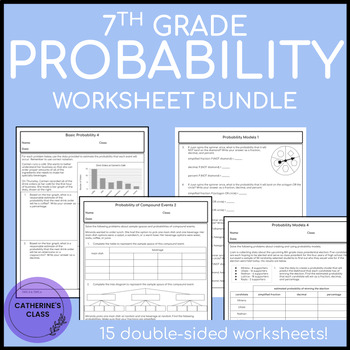7th Grade Math Probability Classwork or Homework BUNDLE
- Zip
Products in this Bundle (3)
Also included in
- Are you looking for a full year of CCSS-aligned 7th grade math homework? Or practice worksheets to help strengthen your students' skills during class? Whether you're new to teaching 7th grade math or you've had many years of experience, this worksheet bundle is sure to meet your needs and save you cPrice $64.35Original Price $99.00Save $34.65
- A bundle including 30 double-sided worksheets with answer keys for every standard of grade 7 Statistics & Probability CCSS.The bundle also includes scaffolded versions of 3 of the Comparing Distributions (7.SP.B) resource.The worksheets are intended to be assigned as homework or as classwork forPrice $13.30Original Price $19.00Save $5.70
Description
A bundle including 15 double-sided worksheets with answer keys for every standard of grade 7 probability, including 7.SP.C.5, 7.SP.C.6, 7.SP.C.7, and 7.SP.C.8.
I've also created a 7th grade statistics bundle, which you can find by clicking here.
The worksheets are intended to be assigned as homework or as classwork for independent practice or group work. They are also great resources to use for sub plans. The worksheets are meant to be given after a skill has been introduced in class.
Many Different Uses:
- Homework
- Classwork
- Independent Practice
- Group Work
- Test/Quiz Prep
- Sub Plans
- Summer/Vacation Homework
- 7th Grade Review Packet
Topics:
- Determine if an event has a probability near 0, 0.5, or 1.
- Determine the likelihood of an event, given the event’s probability.
- Compare probabilities.
- Use data to estimate probabilities of future events.
- Find the probabilities of simple events as fractions, decimals, and percentages.
- Create probability models & use them to estimate the probabilities of future events.
- Create organized lists, tables, and tree diagrams to represent the sample spaces of compound events.
- Find the probability of compound events.
- Identify simulations that can be used to represent compound events.
Students will:
- Gain confidence and fluency through repeated practice.
- Work with real-world problems.
- Analyze and correct common mistakes.
This BUNDLE includes these resources:
7.SP.C.5 & 7.SP.C.6 Basic Probability Classwork or Homework
7.SP.C.7 Probability Models Classwork or Homework
7.SP.C.8 Probability of Compound Events Classwork or Homework
Save 20% off of the price of the individual resources when you purchase this bundle!
Follow my store by clicking here. :)
The student worksheets do not have “grade 7” written on them; instead, the focus standards appear on the bottom left corner of each worksheet. This gives you the flexibility to use these worksheets with any grade level. For instance, you could use them for intervention with an 8th grader or high schooler who needs extra practice with these skills.
Ideas for using this resource:
- Assign one worksheet a day or a packet of worksheets per week for homework.
- Assign worksheets soon after teaching each standard, or give them to students later to reinforce previously-taught skills.
- Assign these as independent practice or group work in class.
- Give these as classwork or homework to review for quizzes, unit tests, or standardized assessments.
- Give homework or classwork packets containing just one standard, or mix-and-match topics in one packet!
- Use these worksheets for your sub plans! Just make copies of worksheets covering skills you’ve already taught students and leave the answer keys for the sub. :)
- Use as a tool for intervention.
- Give these worksheets to students for summer homework after completing grade 7.
If you enjoy this resource, check out my other collections of worksheets for the grade 7 CCSS in my store, Catherine’s Class! I have created worksheet sets for each of the grade 7 standards, so you're sure to find just what you need.
This bundle is a license for one teacher and their students. Please purchase additional licenses if you plan to use this resource with your team. Thank you!
Remember to leave a review so that you can earn TPT credits for future purchases!
© Catherine Howland 2023







